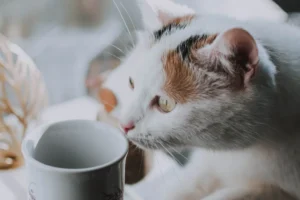Ah, the temptation to spoil our furry companions with the sweet treats we enjoy—isn’t it just purr-suasive? But when it comes to sharing your chocolate cake with your whiskered pal, that’s a slice of trouble you don’t want to serve.
By the end of this read, you’ll have a clear understanding of whether chocolate cake is a feline-friendly snack or a no-go.
Key takeaways:
- Chocolate contains theobromine and caffeine, which are toxic to cats and can cause symptoms ranging from vomiting and diarrhea to seizures and heart failure.
- In case of accidental chocolate cake ingestion, assess the amount, watch for symptoms, and immediately consult your vet for potential emergency treatment.
- Prevent cat chocolate exposure by securing sweets out of reach, training your cat with positive reinforcement, and creating a distracting “decoy setup” with cat-safe treats and toys.
Is Chocolate Safe for Cats?
When it comes to our feline friends and their encounters with chocolate, let’s clear up any confusion right off the bat: chocolate is a no-go for cats.
This isn’t because they are picky eaters or because it’ll spoil their dinner – the real reason is that chocolate contains substances that are downright toxic to cats. Theobromine and caffeine are the main culprits here. Both of these stimulate the nervous system and can lead to a slew of health problems for your kitty.
Cats have a much lower tolerance for theobromine and caffeine than we do. Even a little bit can lead to symptoms like rapid heart rate, vomiting, diarrhea, muscle tremors, restlessness, and in severe cases, seizures. Now, you might love a good chocolate buzz, but for cats, it’s an entirely different and dangerous story. Simply put, keeping chocolate away from your cat isn’t just a good idea – it’s a must to ensure their safety and well-being.
What Happens if My Cat Eats Chocolate Cake?
Imagine your furry buddy somehow gets a paw on that slice of chocolate cake you left unattended. The aftermath might not be pretty. Depending on the amount and type of chocolate cake ingested, the size of your cat, and their overall health, reactions can vary from mild to potentially fatal.
Let’s break down what you might witness:
- Mild symptoms: Hyperactivity, diarrhea, increased thirst.
- Moderate symptoms: Vomiting, abnormal heart rate, tremors.
- Severe symptoms: Seizures, collapse, or even heart failure.
Keep in mind that darker, richer chocolate cakes will have higher levels of theobromine and caffeine, which spells more trouble.
If you catch your cat in the act or notice any unusual behavior after they’ve snuck a bite, it’s time to act promptly. Call your vet or an emergency animal poison control center immediately. They might advise you to bring your cat in right away or give you specific instructions to handle the situation at home—either way, quick action can be a game-changer for your cat’s health.
Can Cats Have Any Kind of Cake?
After that little scare with chocolate cake, you might wonder if there’s any type of cake that’s cat-friendly. While cats may not be able to enjoy the wonders of a classic birthday cake, there are still some options. But before you go baking a feline-friendly concoction, remember that a cat’s diet should be primarily high-quality cat food specifically formulated for their nutritional needs.
Sugar, whether it’s in chocolate cake or any other cake, isn’t great for cats. Among other things, it can lead to obesity and dental problems. Non-chocolate cakes might not pose the same toxic risk, but they aren’t a healthy choice either. That being said, if you’re absolutely determined to celebrate your kitty’s milestone with a cake, opt for something homemade with cat-safe ingredients like pureed pumpkin or carrot, and avoid any sweeteners or unhealthy fats.
For a cat-safe cake recipe, consider a simple mix of canned tuna or salmon, egg, and a bit of flour—bake it until firm, and voilà, you’ve got a feline feast that’s more in line with their dietary needs.
Remember, treats should only make up a small portion of your cat’s diet—think of them like the cherry on top, not the cake itself. It’s always best to consult with your vet before introducing any new foods into your cat’s diet, as they can provide tailored advice based on your cat’s health and needs.
So, while the answer to “Can cats eat cake?” isn’t a straightforward yes, with a touch of creativity and a nod to their health, you can still celebrate special moments together—just save the real sweets for the human party-goers.
What Should I Do if My Cat Sneaks a Bite?
Picture this: you turn your back for just a moment, and when you look back, there’s your kitty, chomping down on your chocolate cake. First things first—don’t panic, but act quickly. Here’s the game plan:
-
Assess the Situation: How much has your cat eaten? Is it just a nibble or a significant chunk? The amount of chocolate ingested is critical—more can mean more trouble.
-
Know the Ingredients: What’s in the cake? Dark chocolate is more dangerous than milk chocolate, so check the type.
-
Look for Symptoms: Is your cat acting differently? Symptoms of chocolate toxicity may include vomiting, diarrhea, rapid breathing, increased heart rate, and seizures.
-
Call Your Vet ASAP: Even if your cat seems fine, don’t take chances. Some symptoms of poisoning can take several hours to appear.
When you contact your vet, be ready to provide:
– The type of chocolate and the amount ingested.
– Your cat’s weight, age, and general health.
– An estimate of when the cake was eaten.
– The symptoms you’ve observed, if any.
During the vet visit, expect a thorough examination. The vet may induce vomiting, administer activated charcoal to absorb toxins, or provide supportive care such as IV fluids. Treatments are most effective when given quickly, so your prompt response can be a lifesaver.
How Can I Prevent My Cat from Eating Sweets?
Keeping sweets out of your cat’s reach is crucial—and it’s more than just shutting them away. Here’s the scoop on prevention:
- Store sweets securely: Immediately place your chocolate cake and other sweets in a cat-proof container and stash it in the pantry or fridge.
- Clear the counters: Never leave sweets unattended on the counter, even if you think they’re out of kitty’s reach. Cats are great jumpers and can surprise you with their acrobatics.
Training Techniques:
– Positive reinforcement works wonders: Teach your cat that the kitchen counters are a no-go. If they jump up, firmly say “no” and move them off. Reward them with a treat when they stay down.
– Make counters unappealing: Double-sided tape or aluminum foil can deter your feline friend from wanting to explore countertops.
Now, here’s a unique tip you won’t find just anywhere: Create a decoy setup. Cats are curious creatures by nature, and sometimes, no matter what you do, they can’t resist the call of the kitchen. Set up a small area in your home with cat-safe ‘treats’ and toys—think of a little faux café for your feline. It might just be intriguing enough to keep them away from your desserts.
Remember, the key here is consistency. If your kitty gets mixed signals about where and what’s okay to munch on, they’ll have a much harder time learning the rules. So stick to your guns, and with a little patience and creativity, your sweets—and your cat—will stay safe and sound.
By implementing these strategies, you’re ensuring a healthier, happier life for your furry friend—minus any unauthorized chocolate feasts. Keep these tips in mind, and the next time your cat eyes up that slice of chocolate cake, you’ll be one step ahead.
Alex, a passionate animal lover, has experience in training and understanding animal behavior. As a proud pet parent to two dogs and three cats, he founded AnimalReport.net to share insights from animal experts and expand his knowledge of the animal kingdom.





